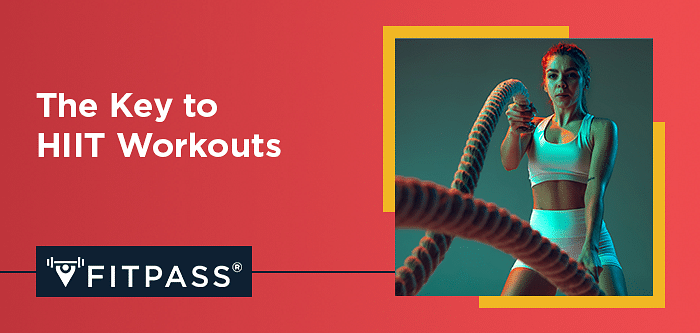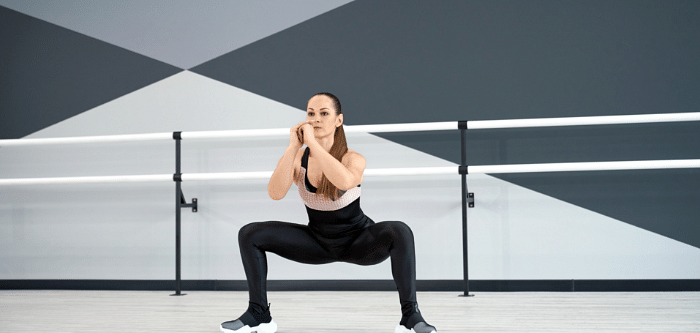Table of Contents
Have you heard about the latest fitness craze called HIIT workouts? HIIT stands for High Intensity Interval Training HIIT. It is a unique exercise combining short bursts of backbreaking work and rest periods. Many people are trying HIIT workouts because they are a super effective and efficient way to fit quickly. In this article, you will learn all about what HIIT workouts are, how to do them properly, and why they provide so many incredible health benefits. Get ready to sweat!
Key Takeaways
- HIIT stands for High-Intensity Interval Training - short bursts of intense exercise followed by recovery periods.
- HIIT workouts build aerobic fitness, burn calories, boost metabolism and melt body fat.4
- Crucial factors are high-intensity work intervals, short recovery periods, and consistent training.
- Do dedicated HIIT workouts 2-3 times per week to prevent overtraining.
- Balance HIIT training with steady-state cardio, strength training, mobility work and rest days.
- Top HIIT exercises: Burpees, Jump Squats, Mountain Climbers, Battle Ropes, Kettlebell Swings.
What Is HIIT?

Let's start by understanding what HIIT workouts, or high-intensity interval training, really means. HIIT is a type of cardiovascular exercise that involves alternating between periods of intense anaerobic exercise and periods of lower-intensity exercise or complete rest.
During the high-intensity intervals, you work as hard as possible. This could mean sprinting, doing explosive strength training moves like burpees or jump squats, or any other exercise that briefly raises your heart rate to around 80-95% of your maximum.
Then, during the recovery intervals, you allow your heart rate to come back down by resting completely or doing low-intensity movement like walking or light jogging. The recovery periods let your body catch its breath before the next hard push.
In a HIIT workout, you would repeat this cycle of working extremely hard for a short period, followed by a recovery period multiple times. A good HIIT session involves 8-10 rounds of 30 seconds of intense work followed by 30-60 seconds of recovery for 20 to 30 minutes.
Use FITPASS to quickly locate and book HIIT workouts near me at top gyms and fitness studios in your area. FITPASS gives you access to over 7500 fitness centres and studios across 44+ cities in India.
Most Important Factors for HIIT Workouts

For HIIT workouts to be effective, there are three key factors:
- High intensity: You need to push yourself as hard as you can during the work intervals. Going at a moderate pace won't cut it. Your heart rate should reach at least 80% of the maximum during these intervals.
- Short recovery periods: The rest breaks should be 30 seconds to 1 minute long, just enough to catch your breath before the next hard effort. You don't want to recover fully.
- Consistent training: To get results from high workouts, you must do them consistently, around 2-3 times per week. Doing just one session will have little impact.
The Key to HIIT Workouts
So, what exactly is the secret that makes high-intensity interval training so beneficial? It all comes down to how it combines those maximum effort bursts with the short recovery periods.
During the intense work intervals, your body has to work extremely hard, which builds cardiovascular fitness, muscle strength, and endurance. Your heart pounds, you start sweating, and you feel the burn as you push through those anaerobic efforts.
But just as you're about to fail, you get a short recovery break. That allows just enough rest for your body to partially recover and catch its breath before repeating the process.
This cycle of extreme work followed by incomplete recovery produces the maximum fitness benefits. Your aerobic system is trained during hard intervals, while your anaerobic system is worked during recovery.
Shocking your body with these intense variations forces it to adapt and improve its fitness capabilities. That's the key!
Benefits of a HIIT Workout

So now that you understand how HIIT workouts work, let's look at some of the excellent benefits they provide:
- Burn More Calories: HIIT's high-intensity nature causes you to burn far more calories than steady-state cardio in the same amount of time. Your body keeps burning calories at an elevated rate even after the workout!
- Improve Cardiovascular Health: The strenuous efforts in HIIT get your heart pumping and improve aerobic fitness and endurance. That can help reduce blood pressure and cholesterol.
- Build Full Body Strength: Many HIIT exercises involve explosive full-body movements that simultaneously work for multiple muscle groups, building functional strength.
- Boost Metabolism: HIIT keeps your metabolism up long after your workout, helping you burn more calories all day.
- Save Time: An efficient HIIT workout can be completed in 20-30 minutes, perfect for a busy schedule!
- Burn Fat and Lose Body Weight: HIIT maximises fat loss by combining intense work with fat-burning recovery periods.
- Endless Variety: You can use unlimited combinations of exercises for HIIT workouts, preventing boredom.
How Many Days a Week Should I Do HIIT Workouts?

While HIIT is highly effective, it's also very demanding on your body. That's why experts recommend doing dedicated HIIT workouts only 2-3 times weekly. Any more than that, and you risk overtraining burnout, or injury.
A sample weekly schedule could look like this:
- Monday: HIIT Workout
- Tuesday: Rest or light moderate-intensity workout
- Wednesday: HIIT Workout
- Thursday: Rest
- Friday: HIIT Workout
- Saturday: Rest or moderate workout
- Sunday: Rest
Allowing rest and recovery days between your high-intensity interval training sessions is essential. On other days, you can complement HIIT with lighter exercises like walking, swimming, or yoga.
Why You Shouldn't Do HIIT for Every Workout?

As beneficial as HIIT workouts are, doing them daily would be a mistake. Here are some key reasons why:
- Injury Risk: Many HIIT exercises' explosive impact puts a lot of stress on your muscles, joints, and connective tissues. Doing this maximal effort daily substantially increases your risk of injury.
- Overtraining: You must allow proper recovery time because HIIT is so intense and pushes your body to its limits. Not doing so can lead to overtraining syndrome, which has symptoms like fatigue, insomnia, and reduced performance.
- Physical and Mental Burnout: Going all-out with HIIT day after day is highly physically and mentally draining. That can quickly lead to burnout, causing you to dread your workouts.
- Hormone Disruption: The physical activity stress of daily HIIT can disrupt your body's hormone levels, such as cortisol, testosterone, and growth hormone, if not balanced with recovery.
The bottom line is that HIIT is best used as a potent training stimulus 2-3 times per week as part of a more balanced overall fitness program. Mixing in lower-intensity sessions is crucial for proper recovery.
HIIT Workouts to Add to Your Training

Exercises for high-intensity interval training are endlessly possible. Any movement that allows you to alternate between maximum effort and recovery periods can work.
Here are some great HIIT exercises to include in your workouts for total body burn:
| Cardio Exercises | Strength Exercises | Core Exercises | Full Body Moves |
|---|---|---|---|
| High Knees | Lunges (forward, reverse, lateral, jump lunges) | Russian Twists | Kettlebell Swings |
| Jumping Jacks | Squats (air, goblet, jump squats) | Bicycle Crunches | Battle Ropes |
| Butt Kicks | Push-ups (standard, spiderman, plyo) | Wood Choppers | Med Ball Slams |
| Jump Rope | Plank Position (shoulder taps, plank jacks) | Plank Up-Downs | TRX Rows and Face Pulls |
| Burpees | |||
| Mountain Climbers |
Mix and match different exercises into timed intervals with short rests. The key is keeping the intensity high and the rest periods brief for maximum effectiveness.
Conclusion

There's no denying the incredible effectiveness of HIIT workouts for achieving maximum results in minimal time. High-intensity interval training, with its strategic combination of all-out effort intervals followed by brief recovery periods, is the ultimate workout for improving overall fitness and conditioning.
When performed correctly, HIIT workouts simultaneously build both aerobic and anaerobic capabilities. The high-intensity intervals push your cardiovascular system to its limits, strengthening your heart and lungs. Meanwhile, the short recovery periods allow you to tap into anaerobic energy systems for boosted strength, power, and muscle endurance.
This dual training effect has many compelling benefits: increased metabolism and fat burning, improved cardiovascular health markers like lower blood pressure, greater functional strength for daily activities, and a lean, toned physique. Plus, the very nature of HIIT workouts is that they are relatively brief yet highly challenging, which--- helps maximise exercise adherence and consistency over time.
However, it's crucial to approach HIIT workouts from a proper perspective. Because of their high-intensity, high-impact nature, these workouts place significant physical and mental demands on your body. Doing dedicated high-intensity interval training too frequently can quickly lead to overtraining, injury, burnout, and diminishing returns.
The optimal approach is strategically integrating a couple of HIIT workout sessions into your weekly routine, 2 to 3 times weekly. Balance the intense HIIT days with lower-intensity steady-state cardio, traditional strength training focusing on compound lifts, mobility work, and complete rest days for recovery.
This balanced, well-rounded program allows you to capitalise on the potency of high-intensity interval training while giving your body enough recovery to adapt and grow stronger properly. Be sure to ease into a HIIT program, mastering proper form and gradually increasing volume over time.
When implemented intelligently as part of an overall fitness lifestyle, HIIT workouts can be a game-changer for torching fat, improving conditioning, and developing a body you're genuinely proud of. Embrace the challenge of high-intensity intervals, but pay attention to the need for adequate rest and recovery. Your fitness future is waiting!






